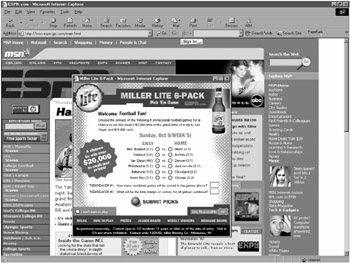Success for Advertisers Is ...
|
It would be na ve to deny that ads—and, therefore, advertisers—are part of nearly all of our experiences. Until the Web, however, they were a minor part of our experience with software. Word processors in the 1980s didn't have commercials. Spreadsheets weren't cosponsored. Killing a monster in Zork didn't get you frequent flier points on United. However, on the Web, ads are everywhere, even inside other ads (just count how many co-branding deals, ads, and product placement markers there are in Figure 3.2, a typical advertising-driven Web site).

Figure 3.2: Advertising units on ESPN.com in 2002.
Now even non-Web products like Intuit's Quickbooks have marketing messages in their interfaces. There are now sponsored links, co-branded advertorial content, interstitial ads, pop-unders, traffic-sharing deals, affiliate programs, affinity incentives, and a host of other kinds of revenue-earning devices. There are pages with 20 different content areas that are essentially ads. Even most subscription services have some revenue that's based on a relationship with a second company.
All these things are parts of the user experience, but they're really there for the advertiser. The user is supposed to see them, act on them, remember them. And, in the end, advertisers are primarily interested in the effectiveness of their advertising for their chosen market. They may be willing to wait and let an advertisement's popularity grow, or they may be interested in a good end-user experience insofar as it can positively affect their ad sales, but ultimately they want to know how much revenue a given ad deal is driving. On the Web, they measure results by traffic or by awareness.
... Traffic
On the Web, there are three primary measures of advertising performance: impressions, click-throughs, and sell-throughs.
Impressions measure how many times the advertisement is inserted into a Web page that is subsequently downloaded. Thus, it's a measurement of how many times an ad can hypothetically be seen.
Unfortunately, just putting an advertisement on a Web page does not guarantee that someone sees it, just as putting up a bill-board does not guarantee that everyone who drives by reads it. So the online advertising industry developed a second measure, the click-through. This is a measure of how many people click on a given advertisement, how much active interest they display in a given ad. The goal of advertising is, of course, more than just interest, so even click-through is still an imperfect measure.
| Note | A traditional Web advertisement is, in one way or another, a link to another site; the advertisers' fundamental goals are frequently in direct opposition to those of the user or company. Simply put, at some level, the advertiser wants the user to leave your company's Web site and go to theirs. And when evaluating the balance in a user experience, this is often the most difficult relationship to resolve. In other kinds of advertising or partnership relationships such as affiliate programs or traffic-sharing deals, this fundamental split isn't as profound or obvious, but it's still a major underlying influence in the relationship between the parties. |
The most direct measurement of advertising effectiveness is the sell-through, which is specific to advertisements where something is for sale. It is a measure of how many people actually bought a given product based on a given advertisement. However, even this measurement has problems: people may be inspired by an ad long after they've left the site with the ad.
... Awareness
Advertising effectiveness is the subject of a large branch of research, but three common metrics that appear in Web site research are brand awareness, brand affinity, and product sales.
Brand awareness measures how many people are aware of the product. Brand affinity measures how much they like it and, more generally, what associations they have with it. Product sales is the bottom line: how many people bought whatever it was that was advertised during the time it was advertised, or soon thereafter.
These three metrics are not necessarily dependent, and can sometimes work against one another. For example, when Oldsmobile launched their "This is not your father's Oldsmobile" campaign, it was initially quite successful, leading to great brand awareness. People remembered it and brand affinity was high: many people in the advertisement's target market reconsidered the image of the car company and saw it as younger and more adventurous than they had previously. Unfortunately, the impact on the bottom line was disappointing because when people went to the showrooms to see the actual cars, they discovered that it was their father's Oldsmobile, so product sales did not reflect the success of the ad campaign. Why? Because the car did not produce a user experience that matched the one that was advertised for it.
In the end, even the best of the traditional marketing measurement systems—Starch scores for print advertising and the Nielsens for television—can produce only approximations of an advertisement's effectiveness in raising awareness and sales. Web metrics are easier to come by (log files abound), but determining the success of an ad campaign is often still an art determined by the gut of the media buyer.
| Note | Standards for Internet advertising can be found on the Internet Advertising Board's Web site at www.iab.net. |
|
EAN: 2147483647
Pages: 144